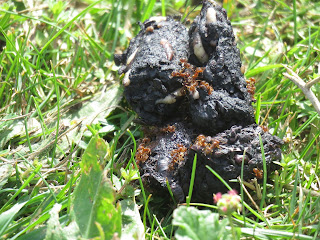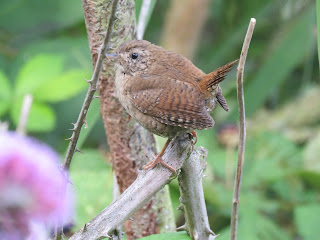It is impossible to go bird watching and not take notice of all the other beautiful, weird and wonderful things that nature has to offer. Since starting birding just over two years ago, I have seen a grass snake catch a frog, watched a dragonfly hatch, been enchanted by wasp spiders (this from an arachnophobe) and developed a niche interest in hoverflies. The whole art of birding - standing quietly, moving slowly and cautiously - perfectly lends itself to seeing and musing on things to which you would never normally give a second glance.
And so it was yesterday at the Waterworks and this time the subject was, well, poo. I have, I suspect, a greater than average knowledge of faeces (being a nurse of 35 years standing, I hasten to add; not because I have another much weirder niche interest), but animal faeces is a whole new world of fascination. Initially I came across this:
I have no idea what creature produced it - fox maybe, or dog - but look at those green bottles! Once you get past the yuk factor of exactly what they are doing - they are stunning. They were like little green robots, busy and metallic and before we dismiss them as gross, let's not forget that it is their larvae that I have used, with great success, in maggot therapy to clean non-healing wounds. They are little life savers!
The brambles just along the path from the wildlife garden have been filled with birds in the last couple of weeks and yesterday was no exception - blackcaps, garden warbler, blue and great tits, common & lesser whitethroat were all feeding on the berries
whilst Dunnock and linnets were feeding on the ground. Also on the ground evidence of rabbits:
Rabbit poo is everywhere now they have recovered from last year's myxie. So here is my first faeces question - why do the green bottles not tuck into rabbit poo? In fact, nothing seems to be attracted to it. Why is this?
The final excreta was in the wildlife garden
The interesting thing about this contribution was the ants. They didn't seem to be doing anything to the faecal matter, rather they appeared to be doing something to the white maggots inside it. I thought at first they might be eating them but I am really not sure as at one point they appeared to be covering one up. Can anybody shed any light on this?
No snake today in the boardwalk pond but I did spot this on the fence.
I may be an arachnophobe but Harvestmen are my total bete noire. They are like the mutants of the creepy crawly world. I mean who needs legs that long?? They don't seem to know what to do with them themselves and they appear to go in all directions at once when they run. Gross!
The hides were much more enjoyable with reed and cetti's warblers visible and vocal and a lovely wren who seemed very bold and uncaring of me and my camera.
Three herons were around - 2 in bed 18 & one in the water area beyond the hides.
In the space of a week the Waterworks seems to have gone from Summer to Autumn with berries everywhere
and the wonderful Hornet Mimic Hoverfly was around again looking stunning
and here's the thing. Birdwatching is so much more than that. It has opened up a whole natural world for me. Half the time I get the birds wrong, sometimes I have no idea what I am looking at and I must drive other bird watchers mad with my incessant questions (PW, JN & GH - you know who you are!) but no matter what I see, even if it is three types of poo - when I go out and see everything that's around me (Harvestmen aside!) I feel like a child at Christmas. (SH)

























































